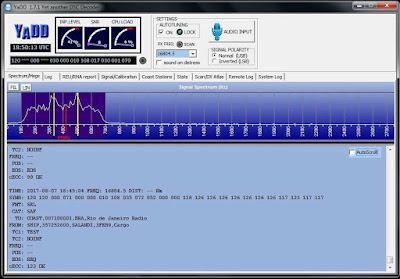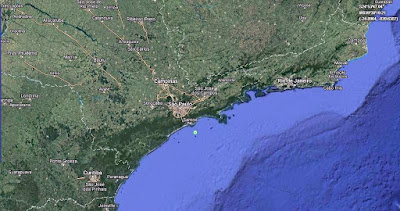 What a Zoo!
What a Zoo!
The question I raised in my article about JT65’s success (“Who’s next?”) has already been answered: Joe Taylor. The same guy that brought us the JT mode of families has devised the mode FT-8, developed together with Steven Franke (K9AN). It’s basically turbo charged JT65, with a message length of only 12.64 seconds and transmission beginnings synced to the next 15 second interval. It’s not as sensitive as JT65, but that might change when a priori information is added at a later stage.
My version of WSJT-X was automatically updated to 1.8.0-rc1 on July 11th and just for fun I decided to check out if there was any FT-8 activity. There was: a couple of VKs and JAs. I was a bit surprised, because I had been monitoring FSQ which has been around for a while already and I couldn’t find any activity. FT-8 had only just been introduced so that was a good sign. It got even better when I noted some European stations popping up in the local evening. I tried my hand at making a QSO, but couldn’t get through, so my first ever FT-8 QSO was with HS7WMU from Thailand. The reason why I couldn’t get through became clear later: the delta loop for 6 meters was still hooked up to the rig! After switching to a proper antenna if became apparent that even my modest verticals didn’t have any problem in getting through to Europe. Even better, stations from the east coast of the US were also coming in fine early evening and I also had no problem working them. (Over here in Taiwan the eastern US is one of the more difficult regions of the world to work).
Over the course of the next few weeks I noticed a steady increase in the number of stations I could receive. The statistics page of pskreporter.info backs this up. As I write this the number of FT-8 spots over the last 2 hours outnumber the JT65 spots 2 to 1. JT9 has already been relegated to the margins, so it seems Amateur Radio’s new favourite mode has become FT-8.
I have always been critical of the JT modes, mainly because they reduce QSOs to a 599 exchange with no possibilities to engage in a more meaningful conversation. Plus, JT65 is boringly slow. So, how do I feel about FT-8? Well, it’s not slow at all. In fact, you don’t even have time to push the appropriate macro buttons on the screen, so let WSPR-X do all the work for you. Even answering a reply to your own CQ can be handled automatically, which frees your hands into doing something else (In my case practising guitar. I’m working on Lindsey Buckingham’s “Never Going Back Again“, but don’t expect any performance soon). Arm chair DXing but still no possibility to start a real conversation with the other party. Not great in my book.

Screen capture of WSJT-X with my first ever FT-8 QSO. Notice the checks with “Auto Seq” and “Call 1st”. Keep these on if you want smooth, automatically sequenced QSOs.
Still, I’ve been playing with FT-8 a lot and it is kind of fun. I normally only log some four hundred QSOs a year and in the last two years that has been reduced to forty or less. Honestly, till July 14 I only had 22 QSOs in my log for 2017. Now I’m way over 240 of which 212 are FT-8 QSOs. July 8th was the highlight so far: SSN of 11 and the K index only 1, so pretty good ionospheric conditions. Within 4.5 hours I worked 50 stations from 19 DXCC entities, working from the east coast to the west coast of the US (I added four new states for my WAS), then into Europe. I hardly had any time to put out CQs, because the next station was already calling me before the previous QSO was finished. The pass band on the scope was filled to the brim, when one anonymous ham sent out the cry that became the title of this post: “What a Zoo!”

Screen capture of pskreporter with all the stations I received on August 8 in the span of 4.5 hours.
He may have found it a zoo, but I like zoos, a lot. All joking aside, the one thing that really attracts me to FT-8 is the fact that you can do real time ionospheric observations. WSPR was meant for this, but the number of WSPR stations is too small and signals are too infrequent to be very accurate in my opinion. By constantly monitoring the FT-8 pass band I already noted a couple of sudden ionospheric disturbances and even a complete black out. Sometimes it only takes minutes for conditions to change from favourable to abismal and as a self reliant ham FT-8 is then a nice monitoring tool to have.
So apart from Antenna Summer, this has also become FT-8 Summer. Until the end of August (summer break) I will be active from 05 to 15 UTC most days, calling CQ a lot. I’m on 20 meters only, so if you see me on your waterfall there give me a call.
Hans "Fong" van den Boogert, BX2ABT, is a regular contributor to AmateurRadio.com and writes from Taiwan. Contact him at [email protected].
 ETH081 – Flying Around the World with Brian Lloyd
ETH081 – Flying Around the World with Brian Lloyd
I’m sure that all of you have heard about Amelia Earhart and how she wanted to become the first woman to fly solo around the world. On June 1, 1937, she and her navigator took off from an airport in Florida and attempted to do just that. She however didn’t make it, but she came close. Her plane disappeared somewhere in the Pacific ocean.
Eighty years later, Brian Lloyd, WB6RQN, decided that he would attempt to fly around the world solo following(for the most part) her historic flight. Thankfully, Brian made it home back here to Texas, however it wasn’t without it’s problems.
In this episode of the Everything Ham Radio Podcast, we talk with Brian about his trip We talk about all the highs and lows, about all the awesome people that helped him along the way and generally about his adventure.
Give this episode a listen, I had a great time talking with Brian and I hope that you enjoy listening in on our conversation. You can find the show notes for the episode as well as listen to it at:
http://www.everythinghamradio.com/podcast/81
Curtis Mohr, K5CLM, is the author/owner of Everything Ham Radio Blog and Youtube channel. Contact him at [email protected].
 SOTA Activation: Mount Peck (W0C/SP-053)
SOTA Activation: Mount Peck (W0C/SP-053)
Mount Peck (W0C/SP-053) is a 12,208 foot summit near Monarch Pass, accessible via a 2.5 mile hike with ~900 feet of elevation gain. This is one of the most pleasant Summits On The Air (SOTA) peaks along the Continental Divide. For most of the route, you are hiking on the Continental Divide Trail (CDT), with outstanding views in all directions. It is always a treat to hike on the CDT, which is like walking on top of the world.
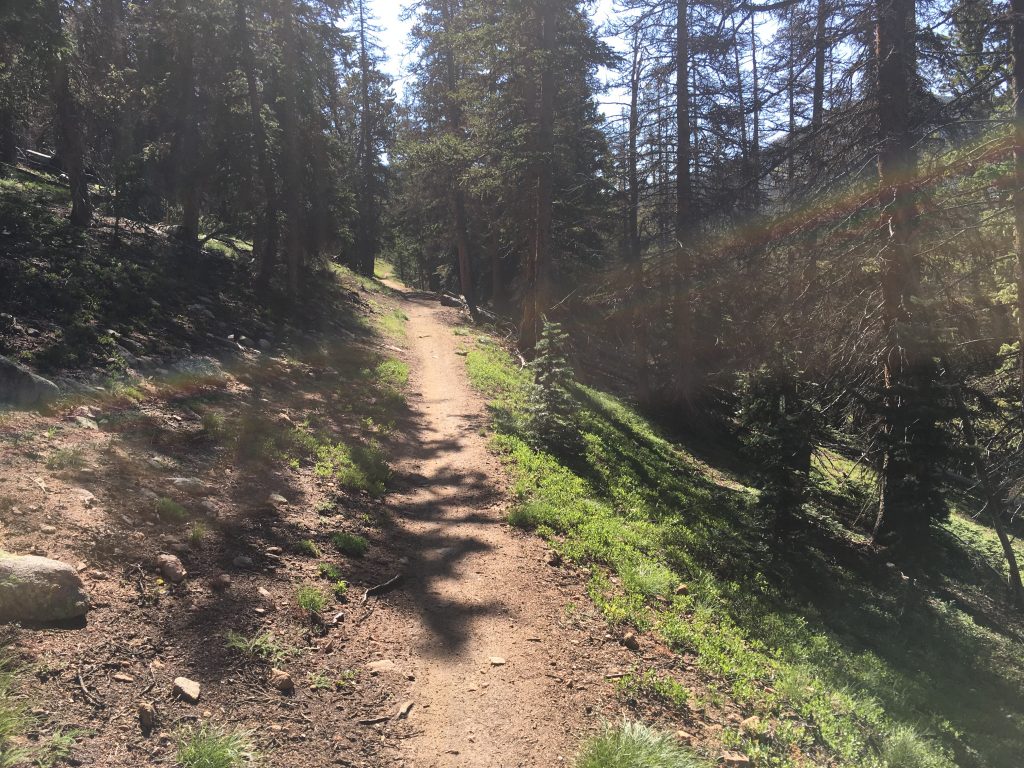
The hike starts at the parking lot at Monarch Pass. (I’ve adapted these directions from Walt W0CP’s notes on the SOTA website.) Take the marked trail that goes behind the building of the Monarch Crest Scenic Tram. Proceed on this trail (really a road at this point) until the CDT exits off to the right (follow it). This section of the CDT is a popular mountain bike trail, so you may encounter bikers on the route. In fact, dirt bikes are also allowed…we encountered a few of them, too.
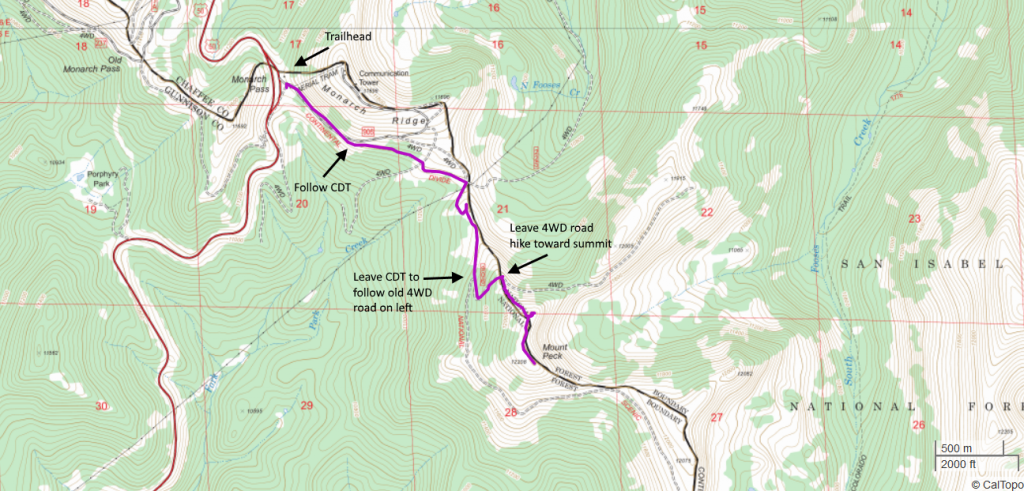
Stay on the CDT until you see an old 4WD road heading off to the left. Leave the CDT at this point and follow the road uphill. When the road crests and before it starts to go back downhill, leave the road and hike off-trail towards the summit. This is the steepest section of the hike where you gain the most elevation. Don’t forget to stop and enjoy the view. (My spouse started singing songs from The Sound of Music at this point.)
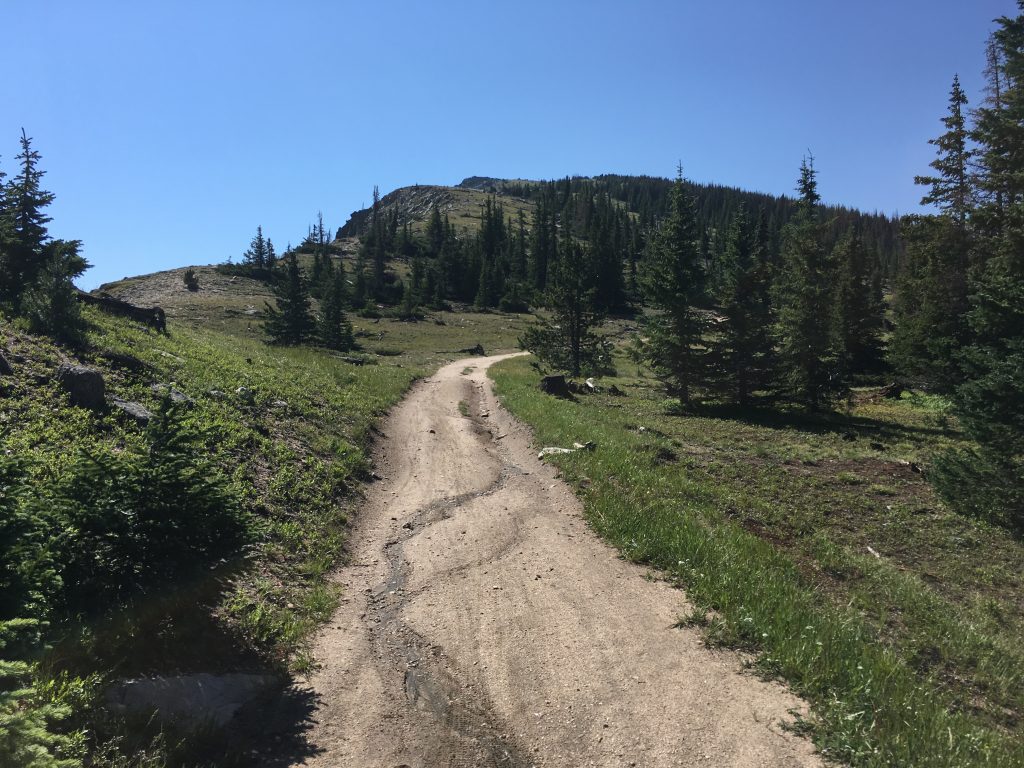
Often hiking on old 4WD roads can seem just like that: hiking on a road and not very enjoyable. This route is not that way…it is actually quite pleasant as the “road” is not rocky or rutted and just seems like an extra-wide trail.
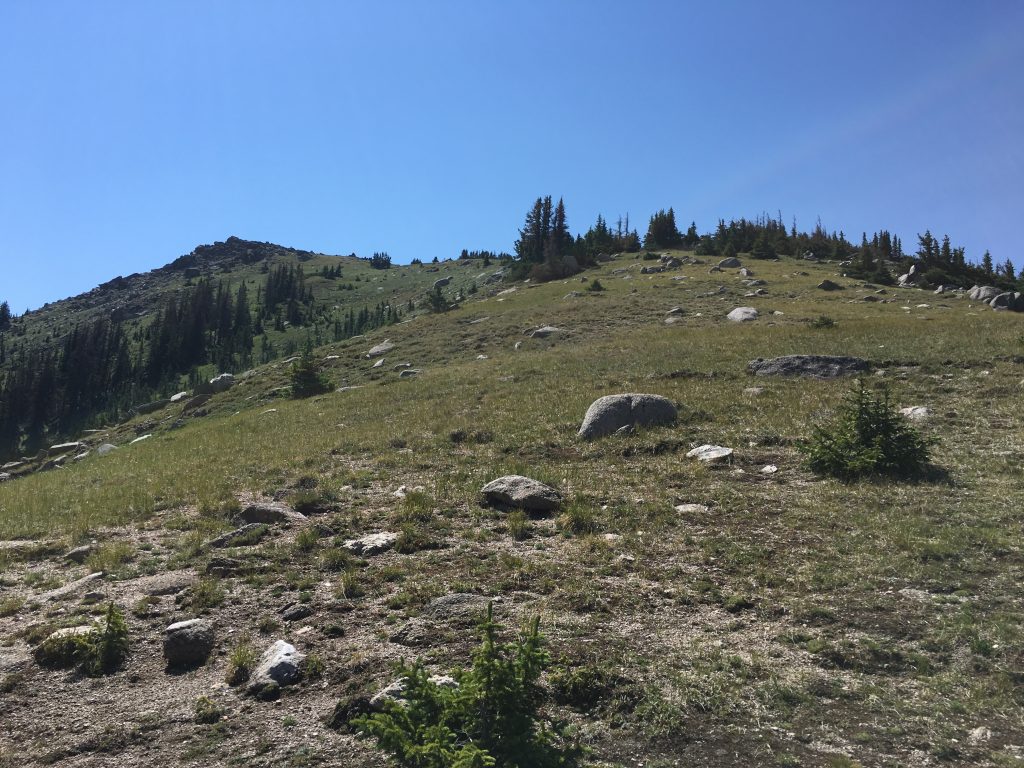
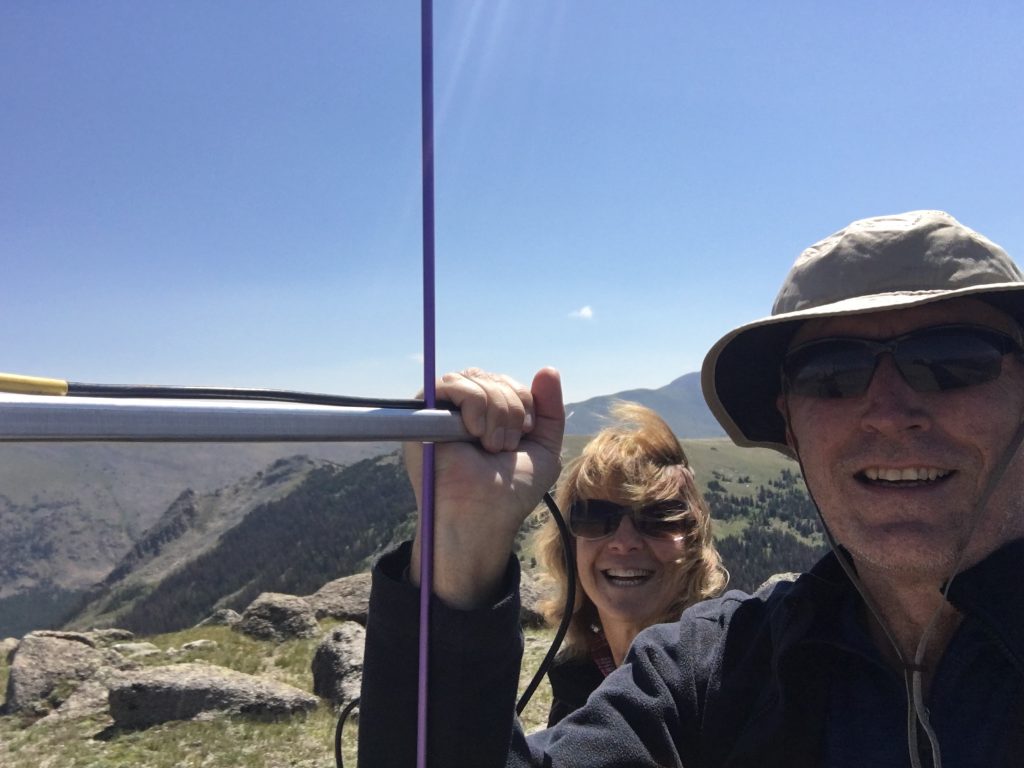
We had great weather on the summit and managed to work a number of stations on 2m fm (Yaesu FT-1D driving a 3-element Arrow yagi antenna). This is a hike that we want to repeat in the future.
Another SOTA summit, South Monarch Ridge (W0C/SP-058) is nearby and it is possible to do both of these summits in the same day.
73, Bob K0NR
The post SOTA Activation: Mount Peck (W0C/SP-053) appeared first on The KØNR Radio Site.
Bob Witte, KØNR, is a regular contributor to AmateurRadio.com and writes from Colorado, USA. Contact him at [email protected].
 Winner Announcement – KB1IFH QSL Card Giveaway
Winner Announcement – KB1IFH QSL Card Giveaway

AmateurRadio.com and KB3IFH QSL Cards are proud to announce
the winner of our free prize drawing!
Frank KR1ZAN
Congratulations!
KB3IFH has an amazing selection of
Premium QSL cards
Eyeball QSL cards
License Plate QSL cards
State QSL cards
and much more!
Visit their gallery to see some of the great designs they’ve done.
Sign up so you won’t miss our next prize drawing!
Matt Thomas, W1MST, is the managing editor of AmateurRadio.com. Contact him at [email protected].
 YADD
YADD
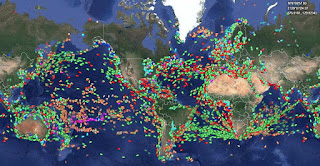 |
| Maritime Traffic - courtesy: www.marinetraffic.com/ |
Until very recently, I had believed that there were no longer any HF maritime operations left, other than various Coast Guard weather announcements and an emergency watch on certain USB frequencies.
Over the past week I have discovered that HF maritime activity is still alive and well, through the worldwide Digital Selective Calling (DSC) system, which has been around in one form or another since the early 90's as part of the Global Maritime Distress and Safety System (GMDSS) ... I guess I was just asleep at the switch, having not been aware of the HF DSC activity!
Although it's not CW, there's still ample opportunity to hear and follow global shipping traffic as vessels of all types contact coastal land stations or call each other. One requirement that keeps the DSC frequencies busy is the requirement for vessels to test their systems at least once per week, providing many opportunities to log various coastal stations or add a new ship to your logbook. Ships can be heard calling coastals for a routine signal test, setting up an SSB phone QSO on a specified frequency or just calling another ship for a test or a phone sked. As well, DSC can be used to send a distress message alert in times of emergency.
Messages are sent in an error-correcting FSK mode, similar to the Navtex system, using the same speed and shift of 100 baud /170Hz. There are a few programs that can be used to decode the DSC messages but one of the best and most popular is the freely available "YADD", by Dirk Claessens .
YADD stands for "Yet Another DSC Decoder" and is an offshoot of Dirk's equally popular and effective "YAND", a free Navtex decoder.
YADD and several other software decoders can be downloaded from the NDB List Info site ... the best source of hands-on information for topics involving NDBs, Navtex, DGPS, DSC DXing and more.
After downloading and installing YADD and setting audio levels correctly, YADD began decoding signals with ease.
The spectrum display at the top of YADD's screen shows the audio passband coming from the receiver. With the receiver in the CW mode, DSC signals will appear on the frequency that your receiver's BFO offset frequency is set for. I prefer an offset of 400Hz so the spectrum display shows the signal at 400Hz, with the tuning cursor centered on a signal. A narrow CW filter should also be selected but no narrower than 170Hz.
Each vessel using the system, as well as the coastal land stations, have a unique 9-digit MMSI number (Maritime Mobile Service Identity). Once the software detects the MMSI numbers being used, it can then display the vessel's name (or the coastal's location and distance) so you know who you are listening to ... it's all very slick!
After initially running my receiver for a few minutes on the 12MHz DSC channel, I decided to look up the location of the first two ships I had heard, using one of the Internet's marine traffic sites.
I was surprised to find that my first catch was a large tanker under way in Kola Bay, having just departed Murmansk, in the Russian Arctic. Vessel number two was also under way along the east coast of South Korea.
The YADD screen above is showing the large bulk carrier 'SALANDI' (3FEB9) calling Rio de Janeiro Radio (PWZ) today on 16804.5KHz.
 |
| Courtesy: Henk Guddee |
I soon discovered an active group of DSC DXers in Yahoo Group's DSC List, which I quickly joined and started asking a lot of questions. The 'Files' section also contains the latest list of ship MMSI numbers so that your YADD look-up text file can be kept up-to-date.
One of the group members, GM4SLV, has set up a wonderful website called YaDDNet devoted to collecting and posting listener's decoded loggings in realtime. One of YADD's features is the ability to automatically upload decoded signals, similar to PSK Reporter. It's an easy 30-second job to configure YADD to upload your spots to the net. His site also contains the latest MMSI look-up file used by YADD which is updated in real time from the latest log postings ... presently at 34,566 vessels!
Clicking on any of the uploaded ship names displayed in the real time YaDDNet log, automatically takes you to an online vessel-tracking site which usually has a picture of the ship along with all of its information, including its present position.
If you set up YADD to do some listening, I'd strongly urge you to also set it up so that your decoded spots are uploaded to the YaDDNet page in real time. Configuring this capability is very simple. Your latest logs will also keep the MMSI database up-to-date for all YADD users.
If, like me, you have missed the maritime CW activity on HF, you may find monitoring DSC traffic of interest ... both ships and coastals. I may even try QSLing some of the coastals again, many of which will still issue a traditional card QSL, upholding a long standing shortwave radio tradition ... but grab them while you can!
 |
| From my collection. Heard 4349KHz CW Aug '96 |
Steve McDonald, VE7SL, is a regular contributor to AmateurRadio.com and writes from British Columbia, Canada. Contact him at [email protected].
 YADD
YADD
 |
| Maritime Traffic - courtesy: www.marinetraffic.com/ |
Until very recently, I had believed that there were no longer any HF maritime operations left, other than various Coast Guard weather announcements and an emergency watch on certain USB frequencies.
Over the past week I have discovered that HF maritime activity is still alive and well, through the worldwide Digital Selective Calling (DSC) system, which has been around in one form or another since the early 90's as part of the Global Maritime Distress and Safety System (GMDSS) ... I guess I was just asleep at the switch, having not been aware of the HF DSC activity!
Although it's not CW, there's still ample opportunity to hear and follow global shipping traffic as vessels of all types contact coastal land stations or call each other. One requirement that keeps the DSC frequencies busy is the requirement for vessels to test their systems at least once per week, providing many opportunities to log various coastal stations or add a new ship to your logbook. Ships can be heard calling coastals for a routine signal test, setting up an SSB phone QSO on a specified frequency or just calling another ship for a test or a phone sked. As well, DSC can be used to send a distress message alert in times of emergency.
Messages are sent in an error-correcting FSK mode, similar to the Navtex system, using the same speed and shift of 100 baud /170Hz. There are a few programs that can be used to decode the DSC messages but one of the best and most popular is the freely available "YADD", by Dirk Claessens .
YADD stands for "Yet Another DSC Decoder" and is an offshoot of Dirk's equally popular and effective "YAND", a free Navtex decoder.
YADD and several other software decoders can be downloaded from the NDB List Info site ... the best source of hands-on information for topics involving NDBs, Navtex, DGPS, DSC DXing and more.
After downloading and installing YADD and setting audio levels correctly, YADD began decoding signals with ease.
The spectrum display at the top of YADD's screen shows the audio passband coming from the receiver. With the receiver in the CW mode, DSC signals will appear on the frequency that your receiver's BFO offset frequency is set for. I prefer an offset of 400Hz so the spectrum display shows the signal at 400Hz, with the tuning cursor centered on a signal. A narrow CW filter should also be selected but no narrower than 170Hz.
Each vessel using the system, as well as the coastal land stations, have a unique 9-digit MMSI number (Maritime Mobile Service Identity). Once the software detects the MMSI numbers being used, it can then display the vessel's name (or the coastal's location and distance) so you know who you are listening to ... it's all very slick!
After initially running my receiver for a few minutes on the 12MHz DSC channel, I decided to look up the location of the first two ships I had heard, using one of the Internet's marine traffic sites.
I was surprised to find that my first catch was a large tanker under way in Kola Bay, having just departed Murmansk, in the Russian Arctic. Vessel number two was also under way along the east coast of South Korea.
The YADD screen above is showing the large bulk carrier 'SALANDI' (3FEB9) calling Rio de Janeiro Radio (PWZ) today on 16804.5KHz.
 |
| Courtesy: Henk Guddee |
I soon discovered an active group of DSC DXers in Yahoo Group's DSC List, which I quickly joined and started asking a lot of questions. The 'Files' section also contains the latest list of ship MMSI numbers so that your YADD look-up text file can be kept up-to-date.
One of the group members, GM4SLV, has set up a wonderful website called YaDDNet devoted to collecting and posting listener's decoded loggings in realtime. One of YADD's features is the ability to automatically upload decoded signals, similar to PSK Reporter. It's an easy 30-second job to configure YADD to upload your spots to the net. His site also contains the latest MMSI look-up file used by YADD which is updated in real time from the latest log postings ... presently at 34,566 vessels!
Clicking on any of the uploaded ship names displayed in the real time YaDDNet log, automatically takes you to an online vessel-tracking site which usually has a picture of the ship along with all of its information, including its present position.
If you set up YADD to do some listening, I'd strongly urge you to also set it up so that your decoded spots are uploaded to the YaDDNet page in real time. Configuring this capability is very simple. Your latest logs will also keep the MMSI database up-to-date for all YADD users.
If, like me, you have missed the maritime CW activity on HF, you may find monitoring DSC traffic of interest ... both ships and coastals. I may even try QSLing some of the coastals again, many of which will still issue a traditional card QSL, upholding a long standing shortwave radio tradition ... but grab them while you can!
 |
| From my collection. Heard 4349KHz CW Aug '96 |
Steve McDonald, VE7SL, is a regular contributor to AmateurRadio.com and writes from British Columbia, Canada. Contact him at [email protected].
 NAQP CW contest.
NAQP CW contest.
Mike Weir, VE9KK, is a regular contributor to AmateurRadio.com and writes from New Brunswick, Canada. Contact him at [email protected].


